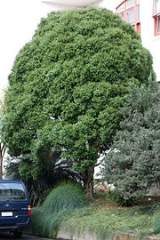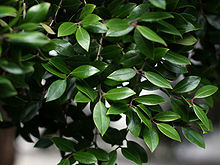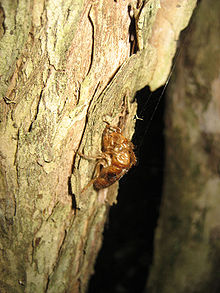
Metrosideros bartlettii
Encyclopedia
Bartlett's rātā or the Cape Reinga white rātā, is one of twelve Metrosideros
species endemic to New Zealand
and is notable for its extreme rarity and its white flowers, somewhat uncommon in that genus of red-flowered trees and plants. Its natural range is in the far north of the North Island
at Te Paki, in three patches of dense native forest near Spirits Bay
(34° S) that escaped destruction by fire, namely Radar Bush, Kohuronaki Bush, and Unuwhao Bush. Only 34 adult trees are known to exist in the wild. The lack of fossil evidence elsewhere suggests that the tree may always have been restricted to the North Cape area, which was an island until it was connected to the mainland by the sandspit that constitutes Ninety Mile Beach
.
 Metrosideros bartlettii was discovered by John Bartlett, a schoolteacher from Auckland
Metrosideros bartlettii was discovered by John Bartlett, a schoolteacher from Auckland
, in 1975. He found an unusual tree growing in Radar Bush, 9.5 km south-east of Cape Reinga. Almost ten years passed before the flowers were collected, making possible a scientific description of the tree. Bartlett's rātā grows to a height of up to thirty metres, usually beginning life as a hemi-epiphyte on taraire (Beilschmiedia tarairi), pūriri (Vitex lucens), rewarewa (Knightia excelsa) or tree ferns (Cyathea
spp.). Occasionally, the tree is found growing on the ground on rock outcrops and rocky cliffs. The tree bears white flowers made up of a mass of stamen
s in November or December. Seed ripens in March or April. The trunk is up to 1.5 m in diameter. Apart from the colour of the flowers, Bartlett's rātā resembles northern rātā (Metrosideros robusta
) but can be distinguished by the small white flowers and by the leaves, which taper to a point at the tip, while those of northern rātā are notched at the tip. Also distinctive is the white or whitish-grey bark that peels easily into soft flakes, which it is thought may offer resistance to fire damage. This may have been a key factor in the tree's precarious survival in an area prone to forest fire.
 Although in the plant is in cultivation, the majority of cultivated plants come from one tree. Only 34 adult Bartlett's rātā are known to exist in the wild, and most of these are growing on privately-owned land. Many of the specimens are isolated from other trees with the result that there is minimal transfer of pollen and few seeds are set. (Analyses of the DNA have shown that there is very little genetic variation)?. The species is also vulnerable to browsing animals, and at risk of destruction by fire or by changes in the land management practices of the landowners.
Although in the plant is in cultivation, the majority of cultivated plants come from one tree. Only 34 adult Bartlett's rātā are known to exist in the wild, and most of these are growing on privately-owned land. Many of the specimens are isolated from other trees with the result that there is minimal transfer of pollen and few seeds are set. (Analyses of the DNA have shown that there is very little genetic variation)?. The species is also vulnerable to browsing animals, and at risk of destruction by fire or by changes in the land management practices of the landowners.
Metrosideros
Metrosideros is a genus of approximately 50 trees, shrubs, and vines native to the islands of the Pacific Ocean, from the Philippines to New Zealand and including the Bonin Islands, Polynesia, and Melanesia, with an anomalous outlier in South Africa. Most of the tree forms are small, but some are...
species endemic to New Zealand
New Zealand
New Zealand is an island country in the south-western Pacific Ocean comprising two main landmasses and numerous smaller islands. The country is situated some east of Australia across the Tasman Sea, and roughly south of the Pacific island nations of New Caledonia, Fiji, and Tonga...
and is notable for its extreme rarity and its white flowers, somewhat uncommon in that genus of red-flowered trees and plants. Its natural range is in the far north of the North Island
North Island
The North Island is one of the two main islands of New Zealand, separated from the much less populous South Island by Cook Strait. The island is in area, making it the world's 14th-largest island...
at Te Paki, in three patches of dense native forest near Spirits Bay
Spirits Bay
Spirits Bay is located at the northern end of the Aupouri Peninsula at the northern tip of New Zealand's North Island. At the western end of the bay is Cape Reinga, from which, according to Māori legend the spirits of the dead leave for their journey to the afterlife .The bay is 12 kilometres in...
(34° S) that escaped destruction by fire, namely Radar Bush, Kohuronaki Bush, and Unuwhao Bush. Only 34 adult trees are known to exist in the wild. The lack of fossil evidence elsewhere suggests that the tree may always have been restricted to the North Cape area, which was an island until it was connected to the mainland by the sandspit that constitutes Ninety Mile Beach
Ninety Mile Beach, New Zealand
Ninety Mile Beach is a beach located on the western coast of the far north of the North Island of New Zealand. It stretches from just west of Kaitaia towards Cape Reinga along the Aupouri Peninsula. It begins close to the headland of Reef Point, to the west of Ahipara Bay, sweeping briefly...
.
Description

Auckland
The Auckland metropolitan area , in the North Island of New Zealand, is the largest and most populous urban area in the country with residents, percent of the country's population. Auckland also has the largest Polynesian population of any city in the world...
, in 1975. He found an unusual tree growing in Radar Bush, 9.5 km south-east of Cape Reinga. Almost ten years passed before the flowers were collected, making possible a scientific description of the tree. Bartlett's rātā grows to a height of up to thirty metres, usually beginning life as a hemi-epiphyte on taraire (Beilschmiedia tarairi), pūriri (Vitex lucens), rewarewa (Knightia excelsa) or tree ferns (Cyathea
Cyathea
Cyathea is a genus of tree ferns, the type genus of the fern order Cyatheales. They are mostly terrestrial ferns, usually with a single tall stem. Rarely, the trunk may be branched or creeping. Many species also develop a fibrous mass of roots at the base of the trunk. The genus has a pantropical...
spp.). Occasionally, the tree is found growing on the ground on rock outcrops and rocky cliffs. The tree bears white flowers made up of a mass of stamen
Stamen
The stamen is the pollen producing reproductive organ of a flower...
s in November or December. Seed ripens in March or April. The trunk is up to 1.5 m in diameter. Apart from the colour of the flowers, Bartlett's rātā resembles northern rātā (Metrosideros robusta
Metrosideros robusta
Northern rātā , is a huge forest tree endemic to New Zealand. It grows up to 25 m or taller, and usually begins its life as a hemiepiphyte high in the branches of a mature forest tree; over centuries the young tree sends descending and girdling roots down and around the trunk of its host,...
) but can be distinguished by the small white flowers and by the leaves, which taper to a point at the tip, while those of northern rātā are notched at the tip. Also distinctive is the white or whitish-grey bark that peels easily into soft flakes, which it is thought may offer resistance to fire damage. This may have been a key factor in the tree's precarious survival in an area prone to forest fire.
Conservation

Cultivation
Bartlett's rātā grows readily from fresh seed, and prefers sunny sites with fertile, well drained soil. It can also be propagated from hardwood cuttings, although these may be very slow to take root. Plants in cultivation in New Zealand are relatively hardy in a range of conditions, and have shown tolerance of mild frosts, which are unknown in the natural habitat.See also
- Northern rātāMetrosideros robustaNorthern rātā , is a huge forest tree endemic to New Zealand. It grows up to 25 m or taller, and usually begins its life as a hemiepiphyte high in the branches of a mature forest tree; over centuries the young tree sends descending and girdling roots down and around the trunk of its host,...
- Southern rātāMetrosideros umbellataSouthern rātā , is a tree endemic to New Zealand. It grows up to 15 m. or more tall with a trunk up to 1 m. or more in diameter. It produces masses of red flowers in summer...
- Scarlet rātā vineMetrosideros fulgensMetrosideros fulgens is a forest liane or vine endemic to New Zealand. It occurs in coastal and lowland forest throughout the North Island and on the west coast of the South Island...

